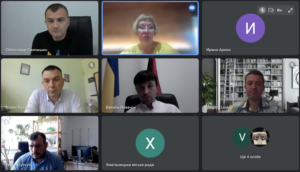On June 21st, the USAID Energy Security Project (ESP) presented the Heat Supply Scheme of Khmelnytskyi to the local authorities and discussed the prospects for implementing the recommended scenario of the document.

Oleksandr Symchyshyn, the Mayor of Khmelnytskyi, thanked USAID ESP for assistance during the 2022 – 2023 heating season and noted that the last heating season was the most difficult one due to russia’s constant shelling, aiming to leave schools, childcare facilities, and hospitals without heat, electricity, and water. “But we coped with this challenge thanks to the assistance provided by the USAID Energy Security Project, including generators, materials to restore the heat networks, emergency, and repair machinery, etc. Our city has been closely cooperating with USAID for nine years, and we consider this cooperation exemplary, as it is always efficient!” said the Mayor.
Currently, the city is actively preparing for the new heating season. Thus ongoing cooperation with USAID ESP is extremely important. According to the city mayor, the municipality supports district heating, which turned out to be more efficient during the crises than the individual heating units for apartments and allowed to maintain steady heat temperature in residential buildings during the previous heating season. Mayor Symchyshyn added that the heat supply scheme of Khmelnytskyi developed by USAID ESP experts is a realistic project ready to be implemented, while several other projects are already being implemented.
Diana Korsakaite, the USAID ESP District Heating Sector Lead: “We will keep supporting, to the extent we can, the coordination process of the heat supply scheme of the city of Khmelnytskyi until it is approved, and we will consider supporting specific projects within that scheme.”
The strategy developed by USAID ESP is focused on providing the city’s inhabitants with the most reliable heat supply system at an affordable price and, in the next ten years (2022-2032), reforming and developing the district heating systems in Khmelnytskyi ensuring that at least 30% of Khelmenytskyi’s energy comes from renewable sources, 50% from waste heat, 75% from heat generation produced in the process of cogeneration or 50% from a combination of such energy and heat.
The Khmelnytskyi’s heat supply scheme comprises several stages of implementation.
- The first stage (3-5 years) includes actions to improve the adaptability of heat sources to the changes in heat consumption (according to demand), the introduction of automated remote commercial metering, implementation of projects equipping solid fuel boiler houses, modernization of pump equipment to minimize consumption, etc.
- The second stage (5-7 years) makes it possible to regulate heat supply at the inlet of residential buildings under an independent connection scheme, as well as implement cogeneration plant projects, etc.
- The third stage (7-10 years) enables the implementation of loss reduction actions in networks (up to 13% and less) and ensures that at least 30% of heat generation comes from renewable energy sources (RES) and efficient cogeneration.
As the Mayor of Khmelnytskyi noted, the scenario recommended by USAID ESP experts is an optimal one and ready to be discussed with the local community in coordination with the Ministry for Communities, Territories and Infrastructure Development of Ukraine, as well as for the further adoption by the city council.
